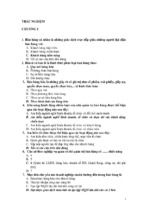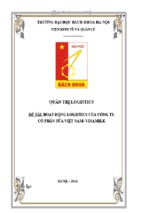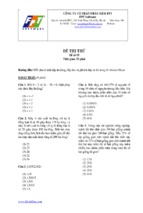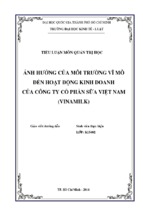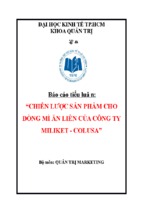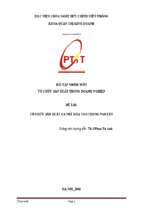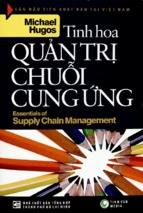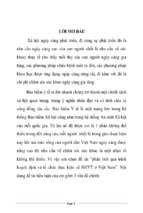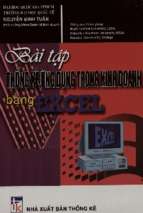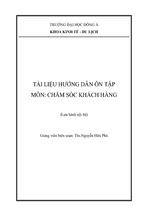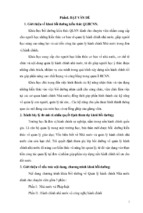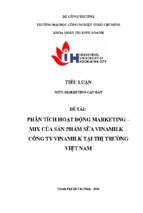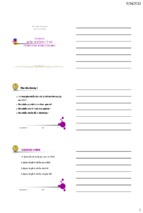How to Pitch a Brilliant Idea
Kimberly D Elsbach
University of California, Davis
4,688 words
1 September 2003
Harvard Business Review
117
0017-8012
English
Copyright (c) 2003 by the President and Fellows of Harvard College. All rights reserved.
Coming up with creative ideas is easy; selling them to strangers is hard. All too often, entrepreneurs, sales
executives, and marketing managers go to great lengths to show how their new business plans or creative
concepts are practical and high margin—only to be rejected by corporate decision makers who don’t seem
to understand the real value of the ideas. Why does this happen?
It turns out that the problem has as much to do with the seller’s traits as with an idea’s inherent quality.
The person on the receiving end tends to gauge the pitcher’s creativity as well as the proposal itself. And
judgments about the pitcher’s ability to come up with workable ideas can quickly and permanently
overshadow perceptions of the idea’s worth. We all like to think that people judge us carefully and
objectively on our merits. But the fact is, they rush to place us into neat little categories—they stereotype
us. So the first thing to realize when you’re preparing to make a pitch to strangers is that your audience is
going to put you into a box. And they’re going to do it really fast. Research suggests that humans can
categorize others in less than 150 milliseconds. Within 30 minutes, they’ve made lasting judgments about
your character.
These insights emerged from my lengthy study of the $50 billion U.S. film and television industry.
Specifically, I worked with 50 Hollywood executives involved in assessing pitches from screenwriters. Over
the course of six years, I observed dozens of 30-minute pitches in which the screenwriters encountered the
“catchers” for the first time. In interviewing and observing the pitchers and catchers, I was able to discern
just how quickly assessments of creative potential are made in these high-stakes exchanges. (The deals
that arise as a result of successful screenplay pitches are often multimillion-dollar projects, rivaling in scope
the development of new car models by Detroit’s largest automakers and marketing campaigns by New
York’s most successful advertising agencies.) To determine whether my observations applied to business
settings beyond Hollywood, I attended a variety of product-design, marketing, and venture-capital pitch
sessions and conducted interviews with executives responsible for judging creative, high-stakes ideas from
pitchers previously unknown to them. In those environments, the results were remarkably similar to what I
had seen in the movie business.
People on the receiving end of pitches have no formal, verifiable, or objective measures for assessing that
elusive trait, creativity. Catchers—even the expert ones—therefore apply a set of subjective and often
inaccurate criteria very early in the encounter, and from that point on, the tone is set. If a catcher detects
subtle cues indicating that the pitcher isn’t creative, the proposal is toast. But that’s not the whole story.
I’ve discovered that catchers tend to respond well if they are made to feel that they are participating in an
idea’s development.
The pitchers who do this successfully are those who tend to be categorized by catchers into one of three
prototypes. I call them the showrunner, the artist, and the neophyte. Showrunners come off as
professionals who combine creative inspiration with production know-how. Artists appear to be quirky and
unpolished and to prefer the world of creative ideas to quotidian reality. Neophytes tend to be—or act as if
they were—young, inexperienced, and naive. To involve the audience in the creative process, showrunners
deliberately level the power differential between themselves and their catchers; artists invert the
differential; and neophytes exploit it. If you’re a pitcher, the bottom-line implication is this: By successfully
projecting yourself as one of the three creative types and getting your catcher to view himself or herself as
a creative collaborator, you can improve your chances of selling an idea.
My research also has implications for those who buy ideas: Catchers should beware of relying on
stereotypes. It’s all too easy to be dazzled by pitchers who ultimately can’t get their projects off the ground,
and it’s just as easy to overlook the creative individuals who can make good on their ideas. That’s why it’s
important for the catcher to test every pitcher, a matter we’ll return to in the following pages.
The Sorting Hat
In the late 1970s, psychologists Nancy Cantor and Walter Mischel, then at Stanford University,
demonstrated that we all use sets of stereotypes—what they called “person prototypes”—to categorize
strangers in the first moments of interaction. Though such instant typecasting is arguably unfair, pattern
matching is so firmly hardwired into human psychology that only conscious discipline can counteract it.
Yale University creativity researcher Robert Sternberg contends that the prototype matching we use to
assess originality in others results from our implicit belief that creative people possess certain traits—
unconventionality, for example, as well as intuitiveness, sensitivity, narcissism, passion, and perhaps youth.
We develop these stereotypes through direct and indirect experiences with people known to be creative,
from personally interacting with the 15-year-old guitar player next door to hearing stories about Pablo
Picasso.
When a person we don’t know pitches an idea to us, we search for visual and verbal matches with those
implicit models, remembering only the characteristics that identify the pitcher as one type or another. We
subconsciously award points to people we can easily identify as having creative traits; we subtract points
from those who are hard to assess or who fit negative stereotypes.
In hurried business situations in which executives must evaluate dozens of ideas in a week, or even a day,
catchers are rarely willing to expend the effort necessary to judge an idea more objectively. Like Harry
Potter’s Sorting Hat, they classify pitchers in a matter of seconds. They use negative stereotyping to rapidly
identify the no-go ideas. All you have to do is fall into one of four common negative stereotypes, and the
pitch session will be over before it has begun. (For more on these stereotypes, see the sidebar “How to Kill
Your Own Pitch.”) In fact, many such sessions are strictly a process of elimination; in my experience, only
1% of ideas make it beyond the initial pitch.
Unfortunately for pitchers, type-based elimination is easy, because negative impressions tend to be more
salient and memorable than positive ones. To avoid fast elimination, successful pitchers—only 25% of those
I have observed—turn the tables on the catchers by enrolling them in the creative process. These pitchers
exude passion for their ideas and find ways to give catchers a chance to shine. By doing so, they induce the
catchers to judge them as likable collaborators. Oscar-winning writer, director, and producer Oliver Stone
told me that the invitation to collaborate on an idea is a “seduction.” His advice to screenwriters pitching an
idea to a producer is to “pull back and project what he needs onto your idea in order to make the story
whole for him.” The three types of successful pitchers have their own techniques for doing this, as we’ll see.
The Showrunner
In the corporate world, as in Hollywood, showrunners combine creative thinking and passion with what
Sternberg and Todd Lubart, authors of Defying the Crowd: Cultivating Creativity in a Culture of Conformity,
call “practical intelligence”—a feel for which ideas are likely to contribute to the business. Showrunners tend
to display charisma and wit in pitching, say, new design concepts to marketing, but they also demonstrate
enough technical know-how to convince catchers that the ideas can be developed according to industrystandard practices and within resource constraints. Though they may not have the most or the best ideas,
showrunners are those rare people in organizations who see the majority of their concepts fully
implemented.
An example of a showrunner is the legendary kitchen-gadget inventor and pitchman Ron Popeil. Perfectly
Page 2
© 2003 Dow Jones Reuters Business Interactive LLC (trading as Factiva). All rights reserved.
coiffed and handsome, Popeil is a combination design master and ringmaster. In his New Yorker account of
Popeil’s phenomenally successful Ronco Showtime Rotisserie & BBQ, Malcolm Gladwell described how Popeil
fuses entertainment skills—he enthusiastically showcases the product as an innovation that will “change
your life”—with business savvy. For his television spots, Popeil makes sure that the chickens are roasted to
exactly the resplendent golden brown that looks best on camera. And he designed the rotisserie’s glass
front to reduce glare, so that to the home cook, the revolving, dripping chickens look just as they do on TV.
The first Hollywood pitcher I observed was a showrunner. The minute he walked into the room, he scored
points with the studio executive as a creative type, in part because of his new, pressed jeans, his
fashionable black turtleneck, and his nice sport coat. The clean hair draping his shoulders showed no hint of
gray. He had come to pitch a weekly television series based on the legend of Robin Hood. His experience as
a marketer was apparent; he opened by mentioning an earlier TV series of his that had been based on a
comic book. The pitcher remarked that the series had enjoyed some success as a marketing franchise,
spawning lunch boxes, bath toys, and action figures.
Showrunners create a level playing field by engaging the catcher in a kind of knowledge duet. They typically
begin by getting the catcher to respond to a memory or some other subject with which the showrunner is
familiar. Consider this give-and-take:
Pitcher: Remember Errol Flynn’s Robin Hood?
Catcher: Oh, yeah. One of my all-time favorites as a kid.
Pitcher: Yes, it was classic. Then, of course, came Costner’s version.
Catcher: That was much darker. And it didn’t evoke as much passion as the original.
Pitcher: But the special effects were great.
Catcher: Yes, they were.
Pitcher: That’s the twist I want to include in this new series.
Catcher: Special effects?
Pitcher: We’re talking a science fiction version of Robin Hood. Robin has a sorcerer in his band of merry
men who can conjure up all kinds of scary and wonderful spells.
Catcher: I love it!
The pitcher sets up his opportunity by leading the catcher through a series of shared memories and
viewpoints. Specifically, he engages the catcher by asking him to recall and comment on familiar movies.
With each response, he senses and then builds on the catcher’s knowledge and interest, eventually guiding
the catcher to the core idea by using a word (“twist”) that’s common to the vocabularies of both producers
and screenwriters.
Showrunners also display an ability to improvise, a quality that allows them to adapt if a pitch begins to go
awry. Consider the dynamic between the creative director of an ad agency and a prospective client, a major
television sports network. As Mallorre Dill reported in a 2001 Adweek article on award-winning advertising
campaigns, the network’s VP of marketing was seeking help with a new campaign for coverage of the
upcoming professional basketball season, and the ad agency was invited to make a pitch. Prior to the
meeting, the network executive stressed to the agency that the campaign would have to appeal to local
markets across the United States while achieving “street credibility” with avid fans.
The agency’s creative director and its art director pitched the idea of digitally inserting two average
teenagers into video of an NBA game. Initially, the catcher frowned on the idea, wondering aloud if viewers
would find it arrogant and aloof. So the agency duo ad-libbed a rap that one teen could recite after scoring
Page 3
© 2003 Dow Jones Reuters Business Interactive LLC (trading as Factiva). All rights reserved.
on all-star Shaquille O’Neal: “I’m fresh like a can of picante. And I’m deeper than Dante in the circles of
hell.” The catcher was taken aback at first; then he laughed. Invited to participate in the impromptu rap
session, the catcher began inserting his own lines. When the fun was over, the presenters repitched their
idea with a slight variation—inserting the teenagers into videos of home-team games for local markets—and
the account was sold to the tune of hundreds of thousands of dollars.
Real showrunners are rare—only 20% of the successful pitchers I observed would qualify. Consequently,
they are in high demand, which is good news for pitchers who can demonstrate the right combination of
talent and expertise.
The Artist
Artists, too, display single-minded passion and enthusiasm about their ideas, but they are less slick and
conformist in their dress and mannerisms, and they tend to be shy or socially awkward. As one Hollywood
producer told me, “The more shy a writer seems, the better you think the writing is, because you assume
they’re living in their internal world.” Unlike showrunners, artists appear to have little or no knowledge of, or
even interest in, the details of implementation. Moreover, they invert the power differential by completely
commanding the catcher’s imagination. Instead of engaging the catcher in a duet, they put the audience in
thrall to the content. Artists are particularly adept at conducting what physicists call “thought experiments,”
inviting the audience into imaginary worlds.
One young screenwriter I observed fit the artist type to perfection. He wore black leather pants and a torn
T-shirt, several earrings in each ear, and a tattoo on his slender arm. His hair was rumpled, his expression
was brooding: Van Gogh meets Tim Burton. He cared little about the production details for the dark, violent
cartoon series he imagined; rather, he was utterly absorbed by the unfolding story. He opened his pitch like
this: “Picture what happens when a bullet explodes inside someone’s brain. Imagine it in slow motion.
There is the shattering blast, the tidal wave of red, the acrid smell of gunpowder. That’s the opening scene
in this animated sci-fi flick.” He then proceeded to lead his catchers through an exciting, detailed narrative
of his film, as a master storyteller would. At the end, the executives sat back, smiling, and told the writer
they’d like to go ahead with his idea.
In the business world, artists are similarly nonconformist. Consider Alan, a product designer at a major
packaged-foods manufacturer. I observed Alan in a meeting with business-development executives he’d
never met. He had come to pitch an idea based on the premise that children like to play with their food.
The proposal was for a cereal with pieces that interlocked in such a way that children could use them for
building things, Legos style. With his pocket-protected laboratory coat and horn-rimmed glasses, Alan
looked very much the absent-minded professor. As he entered the conference room where the suited-andtied executives at his company had assembled, he hung back, apparently uninterested in the PowerPoint
slides or the marketing and revenue projections of the business-development experts. His appearance and
reticence spoke volumes about him. His type was unmistakable.
When it was Alan’s turn, he dumped four boxes of prototype cereal onto the mahogany conference table, to
the stunned silence of the executives. Ignoring protocol, he began constructing an elaborate fort, all the
while talking furiously about the qualities of the corn flour that kept the pieces and the structure together.
Finally, he challenged the executives to see who could build the tallest tower. The executives so enjoyed the
demonstration that they green-lighted Alan’s project.
While artists—who constituted about 40% of the successful pitchers I observed—are not as polished as
show-runners, they are the most creative of the three types. Unlike showrunners and neophytes, artists are
fairly transparent. It’s harder to fake the part. In other words, they don’t play to type; they are the type.
Indeed, it is very difficult for someone who is not an artist to pretend to be one, because genuineness is
what makes the artist credible.
The Neophyte
Neophytes are the opposite of showrunners. Instead of displaying their expertise, they plead ignorance.
Neophytes score points for daring to do the impossible, something catchers see as refreshing.
Page 4
© 2003 Dow Jones Reuters Business Interactive LLC (trading as Factiva). All rights reserved.
Unencumbered by tradition or past successes, neophytes present themselves as eager learners. They
consciously exploit the power differential between pitcher and catcher by asking directly and boldly for
help—not in a desperate way, but with the confidence of a brilliant favorite, a talented student seeking sage
advice from a beloved mentor.
Consider the case of one neophyte pitcher I observed, a young, ebullient screenwriter who had just
returned from his first trip to Japan. He wanted to develop a show about an American kid (like himself) who
travels to Japan to learn to play taiko drums, and he brought his drums and sticks into the pitch session.
The fellow looked as though he had walked off the set of Doogie Howser, M.D. With his infectious smile, he
confided to his catchers that he was not going to pitch them a typical show, “mainly because I’ve never
done one. But I think my inexperience here might be a blessing.”
He showed the catchers a variety of drumming moves, then asked one person in his audience to help him
come up with potential camera angles—such as looking out from inside the drum or viewing it from
overhead—inquiring how these might play on the screen. When the catcher got down on his hands and
knees to show the neophyte a particularly “cool” camera angle, the pitch turned into a collaborative
teaching session. Ignoring his lunch appointment, the catcher spent the next half hour offering suggestions
for weaving the story of the young drummer into a series of taiko performances in which artistic camera
angles and imaginative lighting and sound would be used to mirror the star’s emotions.
Many entrepreneurs are natural neophytes. Lou and Sophie McDermott, two sisters from Australia, started
the Savage Sisters sportswear line in the late 1990s. Former gymnasts with petite builds and spunky
personalities, they cartwheeled into the clothing business with no formal training in fashion or finance.
Instead, they relied heavily on their enthusiasm and optimism and a keen curiosity about the fine points of
retailing to get a start in the highly competitive world of teen fashion. On their shopping outings at local
stores, the McDermott sisters studied merchandising and product placement—all the while asking store
owners how they got started, according to the short documentary film Cutting Their Own Cloth.
The McDermott sisters took advantage of their inexperience to learn all they could. They would ask a store
owner to give them a tour of the store, and they would pose dozens of questions: “Why do you buy this line
and not the other one? Why do you put this dress here and not there? What are your customers like? What
do they ask for most?” Instead of being annoying, the McDermotts were charming, friendly, and fun, and
the flattered retailers enjoyed being asked to share their knowledge. Once they had struck up a relationship
with a retailer, the sisters would offer to bring in samples for the store to test. Eventually, the McDermotts
parlayed what they had learned into enough knowledge to start their own retail line. By engaging the store
owners as teachers, the McDermotts were able to build a network of expert mentors who wanted to see the
neophytes win. Thus neophytes, who constitute about 40% of successful pitchers, achieve their gains
largely by sheer force of personality.
Which of the three types is most likely to succeed? Overwhelmingly, catchers look for showrunners, though
artists and neophytes can win the day through enchantment and charm. From the catcher’s perspective,
however, showrunners can also be the most dangerous of all pitchers, because they are the most likely to
blind through glitz.
Catchers Beware
When business executives ask me for my insights about creativity in Hollywood, one of the first questions
they put to me is, “Why is there so much bad television?” After hearing the stories I’ve told here, they know
the answer: Hollywood executives too often let themselves be wooed by positive stereotypes—particularly
that of the showrunner—rather than by the quality of the ideas. Indeed, individuals who become adept at
conveying impressions of creative potential, while lacking the real thing, may gain entry into organizations
and reach prominence there based on their social influence and impression-management skills, to the
catchers’ detriment.
Real creativity isn’t so easily classified. Researchers such as Sternberg and Lubart have found that people’s
implicit theories regarding the attributes of creative individuals are off the mark. Furthermore, studies have
identified numerous personal attributes that facilitate practical creative behavior. For example, cognitive
Page 5
© 2003 Dow Jones Reuters Business Interactive LLC (trading as Factiva). All rights reserved.
flexibility, a penchant for diversity, and an orientation toward problem solving are signs of creativity; it
simply isn’t true that creative types can’t be down-to-earth.
Those who buy ideas, then, need to be aware that relying too heavily on stereotypes can cause them to
overlook creative individuals who can truly deliver the goods. In my interviews with studio executives and
agents, I heard numerous tales of people who had developed reputations as great pitchers but who had
trouble producing usable scripts. The same thing happens in business. One well-known example occurred in
1985, when Coca-Cola announced it was changing the Coke formula. Based on pitches from market
researchers who had tested the sweeter, Pepsi-like “new Coke” in numerous focus groups, the company’s
top management decided that the new formula could effectively compete with Pepsi. The idea was a
marketing disaster, of course. There was a huge backlash, and the company was forced to reintroduce the
old Coke. In a later discussion of the case and the importance of relying on decision makers who are both
good pitchers and industry experts, Roberto Goizueta, Coca-Cola’s CEO at the time, said to a group of
MBAs, in effect, that there’s nothing so dangerous as a good pitcher with no real talent.
If a catcher senses that he or she is being swept away by a positive stereotype match, it’s important to test
the pitcher. Fortunately, assessing the various creative types is not difficult. In a meeting with a
showrunner, for example, the catcher can test the pitcher’s expertise and probe into past experiences, just
as a skilled job interviewer would, and ask how the pitcher would react to various changes to his or her
idea. As for artists and neophytes, the best way to judge their ability is to ask them to deliver a finished
product. In Hollywood, smart catchers ask artists and neophytes for finished scripts before hiring them.
These two types may be unable to deliver specifics about costs or implementation, but a prototype can
allow the catcher to judge quality, and it can provide a concrete basis for further discussion. Finally, it’s
important to enlist the help of other people in vetting pitchers. Another judge or two can help a catcher
weigh the pitcher’s—and the idea’s—pros and cons and help safeguard against hasty judgments.
One CEO of a Northern California design firm looks beyond the obvious earmarks of a creative type when
hiring a new designer. She does this by asking not only about successful projects but also about work that
failed and what the designer learned from the failures. That way, she can find out whether the prospect is
capable of absorbing lessons well and rolling with the punches of an unpredictable work environment. The
CEO also asks job prospects what they collect and read, as well as what inspires them. These kinds of clues
tell her about the applicant’s creative bent and thinking style. If an interviewee passes these initial tests, the
CEO has the prospect work with the rest of her staff on a mock design project. These diverse interview tools
give her a good indication about the prospect’s ability to combine creativity and organizational skills, and
they help her understand how well the applicant will fit into the group.
***
One question for pitchers, of course, might be, “How do I make a positive impression if I don’t fit into one
of the three creative stereotypes?” If you already have a reputation for delivering on creative promises, you
probably don’t need to disguise yourself as a showrunner, artist, or neophyte—a résumé full of successes is
the best calling card of all. But if you can’t rely on your reputation, you should at least make an attempt to
match yourself to the type you feel most comfortable with, if only because it’s necessary to get a foot in the
catcher’s door.
Another question might be, “What if I don’t want the catcher’s input into the development of my idea?” This
aspect of the pitch is so important that you should make it a priority: Find a part of your proposal that you
are willing to yield on and invite the catcher to come up with suggestions. In fact, my observations suggest
that you should engage the catcher as soon as possible in the development of the idea. Once the catcher
feels like a creative collaborator, the odds of rejection diminish.
Ultimately, the pitch will always remain an imperfect process for communicating creative ideas. But by being
aware of stereotyping processes and the value of collaboration, both pitchers and catchers can understand
the difference between a pitch and a hit.
How to Kill Your Own Pitch
Page 6
© 2003 Dow Jones Reuters Business Interactive LLC (trading as Factiva). All rights reserved.
Before you even get to the stage in the pitch where the catcher categorizes you as a particular creative
type, you have to avoid some dangerous pigeonholes: the four negative stereotypes that are guaranteed to
kill a pitch. And take care, because negative cues carry more weight than positive ones.
The pushover would rather unload an idea than defend it. (“I could do one of these in red, or if you don’t
like that, I could do it in blue.”) One venture capitalist I spoke with offered the example of an entrepreneur
who was seeking funding for a computer networking start-up. When the VCs raised concerns about an
aspect of the device, the pitcher simply offered to remove it from the design, leading the investors to
suspect that the pitcher didn’t really care about his idea.
The robot presents a proposal too formulaically, as if it had been memorized from a how-to book. Witness
the entrepreneur who responds to prospective investors’ questions about due diligence and other business
details with canned answers from his PowerPoint talk.
The used-car salesman is that obnoxious, argumentative character too often deployed in consultancies and
corporate sales departments. One vice president of marketing told me the story of an arrogant consultant
who put in a proposal to her organization. The consultant’s offer was vaguely intriguing, and she asked him
to revise his bid slightly. Instead of working with her, he argued with her. Indeed, he tried selling the same
package again and again, each time arguing why his proposal would produce the most astonishing bottomline results the company had ever seen. In the end, she grew so tired of his wheedling insistence and
inability to listen courteously to her feedback that she told him she wasn’t interested in seeing any more
bids from him.
The charity case is needy; all he or she wants is a job. I recall a freelance consultant who had developed a
course for executives on how to work with independent screenwriters. He could be seen haunting the halls
of production companies, knocking on every open door, giving the same pitch. As soon as he sensed he was
being turned down, he began pleading with the catcher, saying he really, really needed to fill some slots to
keep his workshop going.
Sternberg, Robert J., Lubart, Todd I., Defying the Crowd: Cultivating Creativity in a Culture of Conformity,
Free Press, 1995
How to Kill Your Own Pitch; Textbox
Document HBR0000020030915dz910000d
Page 7
© 2003 Dow Jones Reuters Business Interactive LLC (trading as Factiva). All rights reserved.
Why Good Projects Fail Anyway
Nadim F. Matta; Ronald N. Ashkenas
Robert H. Schaffer & Associates; Robert H. Schaffer & Associates
2,791 words
1 September 2003
Harvard Business Review
109
0017-8012
English
Copyright (c) 2003 by the President and Fellows of Harvard College. All rights reserved.
Big projects fail at an astonishing rate. Whether major technology installations, postmerger integrations, or
new growth strategies, these efforts consume tremendous resources over months or even years. Yet as
study after study has shown, they frequently deliver disappointing returns—by some estimates, in fact, well
over half the time. And the toll they take is not just financial. These failures demoralize employees who
have labored diligently to complete their share of the work. One middle manager at a top pharmaceutical
company told us, “I’ve been on dozens of task teams in my career, and I’ve never actually seen one that
produced a result.”
The problem is, the traditional approach to project management shifts the project teams’ focus away from
the end result toward developing recommendations, new technologies, and partial solutions. The intent, of
course, is to piece these together into a blueprint that will achieve the ultimate goal, but when a project
involves many people working over an extended period of time, it’s very hard for managers planning it to
predict all the activities and work streams that will be needed. Unless the end product is very well
understood, as it is in highly technical engineering projects such as building an airplane, it’s almost
inevitable that some things will be left off the plan. And even if all the right activities have been anticipated,
they may turn out to be difficult, or even impossible, to knit together once they’re completed.
Managers use project plans, timelines, and budgets to reduce what we call “execution risk”—the risk that
designated activities won’t be carried out properly—but they inevitably neglect these two other critical
risks—the “white space risk” that some required activities won’t be identified in advance, leaving gaps in the
project plan, and the “integration risk” that the disparate activities won’t come together at the end. So
project teams can execute their tasks flawlessly, on time and under budget, and yet the overall project may
still fail to deliver the intended results.
We’ve worked with hundreds of teams over the past 20 years, and we’ve found that by designing complex
projects differently, managers can reduce the likelihood that critical activities will be left off the plan and
increase the odds that all the pieces can be properly integrated at the end. The key is to inject into the
overall plan a series of miniprojects—what we call rapid-results initiatives—each staffed with a team
responsible for a version of the hoped-for overall result in miniature and each designed to deliver its result
quickly.
Let’s see what difference that would make. Say, for example, your goal is to double sales revenue over two
years by implementing a customer relationship management (CRM) system for your sales force. Using a
traditional project management approach, you might have one team research and install software packages,
another analyze the different ways that the company interacts with customers (e-mail, telephone, and in
person, for example), another develop training programs, and so forth. Many months later, however, when
you start to roll out the program, you might discover that the salespeople aren’t sold on the benefits. So
even though they may know how to enter the requisite data into the system, they refuse. This very problem
has, in fact, derailed many CRM programs at major organizations.
But consider the way the process might unfold if the project included some rapid-results initiatives. A single
team might take responsibility for helping a small number of users—say, one sales group in one region—
increase their revenues by 25% within four months. Team members would probably draw on all the
Page 8
© 2003 Dow Jones Reuters Business Interactive LLC (trading as Factiva). All rights reserved.
activities described above, but to succeed at their goal, the microcosm of the overall goal, they would be
forced to find out what, if anything, is missing from their plans as they go forward. Along the way, they
would, for example, discover the salespeople’s resistance, and they would be compelled to educate the
sales staff about the system’s benefits. The team may also discover that it needs to tackle other issues,
such as how to divvy up commissions on sales resulting from cross-selling or joint-selling efforts.
When they’ve ironed out all the kinks on a small scale, their work would then become a model for the next
teams, which would either engage in further rapid-results initiatives or roll the system out to the whole
organization—but now with a higher level of confidence that the project will have the intended impact on
sales revenue. The company would see an early payback on its investment and gain new insights from the
team’s work, and the team would have the satisfaction of delivering real value.
In the pages that follow, we’ll take a close look at rapid-results initiatives, using case studies to show how
these projects are selected and designed and how they are managed in conjunction with more traditional
project activities.
How Rapid-Results Teams Work
Let’s look at an extremely complex project, a World Bank initiative begun in June 2000 that aims to improve
the productivity of 120,000 small-scale farmers in Nicaragua by 30% in 16 years. A project of this
magnitude entails many teams working over a long period of time, and it crosses functional and
organizational boundaries.
They started as they had always done: A team of World Bank experts and their clients in the country (in this
case, Ministry of Agriculture officials) spent many months in preparation—conducting surveys, analyzing
data, talking to people with comparable experiences in other countries, and so on. Based on their findings,
these project strategists, designers, and planners made an educated guess about the major streams of work
that would be required to reach the goal. These work streams included reorganizing government institutions
that give technical advice to farmers, encouraging the creation of a private-sector market in agricultural
support services (such as helping farmers adopt new farming technologies and use improved seeds),
strengthening the National Institute for Agricultural Technology (INTA), and establishing an information
management system that would help agricultural R&D institutions direct their efforts to the most productive
areas of research. The result of all this preparation was a multiyear project plan, a document laying out the
work streams in detail.
But if the World Bank had kept proceeding in the traditional way on a project of this magnitude, it would
have been years before managers found out if something had been left off the plan or if the various work
streams could be integrated—and thus if the project would ultimately achieve its goals. By that time,
millions of dollars would have been invested and much time potentially wasted. What’s more, even if
everything worked according to plan, the project’s beneficiaries would have been waiting for years before
seeing any payoff from the effort. As it happened, the project activities proceeded on schedule, but a new
minister of agriculture came on board two years in and argued that he needed to see results sooner than
the plan allowed. His complaint resonated with Norman Piccioni, the World Bank team leader, who was also
getting impatient with the project’s pace. As he said at the time, “Apart from the minister, the farmers, and
me, I’m not sure anyone working on this project is losing sleep over whether farmer productivity will be
improved or not.”
Over the next few months, we worked with Piccioni to help him and his clients add rapid-results initiatives
to the implementation process. They launched five teams, which included not only representatives from the
existing work streams but also the beneficiaries of the project, the farmers themselves. The teams differed
from traditional implementation teams in three fundamental ways. Rather than being partial, horizontal, and
long term, they were results oriented, vertical, and fast. A look at each attribute in turn shows why they
were more effective.
Results Oriented. As the name suggests, a rapid-results initiative is intentionally commissioned to produce a
measurable result, rather than recommendations, analyses, or partial solutions. And even though the goal is
on a smaller scale than the overall objective, it is nonetheless challenging. In Nicaragua, one team’s goal
Page 9
© 2003 Dow Jones Reuters Business Interactive LLC (trading as Factiva). All rights reserved.
was to increase Grade A milk production in the Leon municipality from 600 to 1,600 gallons per day in 120
days in 60 small and medium-size producers. Another was to increase pig weight on 30 farms by 30% in
100 days using enhanced corn seed. A third was to secure commitments from private-sector experts to
provide technical advice and agricultural support to 150 small-scale farmers in the El Sauce (the dry farming
region) within 100 days.
This results orientation is important for three reasons. First, it allows project planners to test whether the
activities in the overall plan will add up to the intended result and to alter the plans if need be. Second, it
produces real benefits in the short term. Increasing pig weight in 30 farms by 30% in just over three
months is useful to those 30 farmers no matter what else happens in the project. And finally, being able to
deliver results is more rewarding and energizing for teams than plodding along through partial solutions.
The focus on results also distinguishes rapid-results initiatives from pilot projects, which are used in
traditionally managed initiatives only to reduce execution risk. Pilots typically are designed to test a
preconceived solution, or means, such as a CRM system, and to work out implementation details before
rollout. Rapid-results initiatives, by contrast, are aimed squarely at reducing white space and integration
risk.
Vertical. Project plans typically unfold as a series of activities represented on a timeline by horizontal bars.
In this context, rapid-results initiatives are vertical. They encompass a slice of several horizontal activities,
implemented in tandem in a very short time frame. By using the term “vertical,” we also suggest a crossfunctional effort, since different horizontal work streams usually include people from different parts of an
organization (or even, as in Nicaragua, different organizations), and the vertical slice brings these people
together. This vertical orientation is key to reducing white space and integration risks in the overall effort:
Only by uncovering and properly integrating any activities falling in the white space between the horizontal
project streams will the team be able to deliver its miniresult. (For a look at the horizontal and vertical work
streams in the Nicaragua project, see the exhibit “The World Bank’s Project Plan.”)
Fast. How fast is fast? Rapid-results projects generally last no longer than 100 days. But they are by no
means quick fixes, which imply shoddy or short-term solutions. And while they deliver quick wins, the more
important value of these initiatives is that they change the way teams approach their work. The short time
frame fosters a sense of personal challenge, ensuring that team members feel a sense of urgency right from
the start that leaves no time to squander on big studies or interorganizational bickering. In traditional
horizontal work streams, the gap between current status and the goal starts out far wider, and a feeling of
urgency does not build up until a short time before the day of reckoning. Yet it is precisely at that point that
committed teams kick into a high-creativity mode and begin to experiment with new ideas to get results.
That kick comes right away in rapid-results initiatives.
A Shift in Accountability
When executives assign a team responsibility for a result, however, the team is free—indeed, compelled—to
find out what activities will be needed to produce the result and how those activities will fit together. This
approach puts white space and integration risk onto the shoulders of the people doing the work. That’s
appropriate because, as they work, they can discover on the spot what’s working and what’s not. And in the
end, they are rewarded not for performing a series of tasks but for delivering real value. Their success is
correlated with benefits to the organization, which will come not only from implementing known activities
but also from identifying and integrating new activities.
The milk productivity team in Nicaragua, for example, found out early on that the quantity of milk
production was not the issue. The real problem was quality: Distributors were being forced to dump almost
half the milk they had bought due to contamination, spoilage, and other problems. So the challenge was to
produce milk acceptable to large distributors and manufacturers that complied with international quality
standards. Based on this understanding, the team leader invited a representative of Parmalat, the biggest
private company in Nicaragua’s dairy sector, to join the team. Collaborating with this customer allowed the
team to understand Parmalat’s quality standards and thus introduce proper hygiene practices to the milk
producers in Leon. The collaboration also identified the need for simple equipment such as a centrifuge that
could test the quality of batches quickly.
Page 10
© 2003 Dow Jones Reuters Business Interactive LLC (trading as Factiva). All rights reserved.
The quality of milk improved steadily in the initial stage of the effort. But then the team discovered that its
goal of tripling sales was in danger due to a logistics problem: There wasn’t adequate storage available for
the additional Grade A milk now being produced. Rather than invest in refrigeration facilities, the Parmalat
team member (now assured of the quality of the milk) suggested that the company conduct collection runs
in the area daily rather than twice weekly.
At the end of 120 days, the milk productivity team (renamed the “clean-milking” team) and the other four
teams not only achieved their goals but also generated a new appreciation for the discovery process. As
team leader Piccioni observed at a follow-up workshop: “I now realize how much of the overall success of
the effort depends on people discovering for themselves what goals to set and what to do to achieve them.”
What’s more, the work is more rewarding for the people involved. It may seem paradoxical, but virtually all
the teams we’ve encountered prefer to work on projects that have results-oriented goals, even though they
involve some risk and require some discovery, rather than implement clearly predefined tasks.
The Leadership Balancing Act
In Nicaragua, the vertical teams drew members from the horizontal teams, but these people continued to
work on the horizontal streams as well, and each team benefited from the work of the others. So, for
example, when the milk productivity team discovered the need to educate farmers in clean-milking
practices, the horizontal training team knew to adjust the design of its overall training programs
accordingly.
The adhesive-material and office-product company Avery Dennison took a similar approach, creating a
portfolio of rapid-results initiatives and horizontal work streams as the basis for its overall growth
acceleration strategy. Just over a year ago, the company was engaged in various horizontal activities like
new technology investments and market studies. The company was growing, but CEO Phil Neal and his
leadership team were not satisfied with the pace. Although growth was a major corporate goal, the
company had increased its revenues by only 8% in two years.
In August 2002, Neal and president Dean Scarborough tested the vertical approach in three North American
divisions, launching 15 rapid-results teams in a matter of weeks. One was charged with securing one new
order for an enhanced product, refined in collaboration with one large customer, within 100 days. Another
focused on signing up three retail chains so it could use that experience to develop a methodology for
moving into new distribution channels. A third aimed to book several hundred thousand dollars in sales in
100 days by providing—through a collaboration with three other suppliers—all the parts needed by a major
customer. By December, it had become clear that the vertical growth initiatives were producing results, and
the management team decided to extend the process throughout the company, supported by an extensive
employee communication campaign. The horizontal activities continued, but at the same time dozens of
teams, involving hundreds of people, started working on rapid-results initiatives. By the end of the first
quarter of 2003, these teams yielded more than $8 million in new sales, and the company was forecasting
that the initiatives would realize approximately $50 million in sales by the end of the year.
Ashkenas, Ronald N., Francis, Suzanne C., Integration Managers: Special Leaders for Special Times, HBR,
2000/Nov-Dec
The World Bank's Project Plan; Textbox
Document HBR0000020030915dz910000c
Page 11
© 2003 Dow Jones Reuters Business Interactive LLC (trading as Factiva). All rights reserved.
Mind Your Pricing Cues
Eric Anderson; Duncan Simester
Northwestern University's Kellogg School of Management; MIT's Sloan School of Management
4,788 words
1 September 2003
Harvard Business Review
96
0017-8012
English
Copyright (c) 2003 by the President and Fellows of Harvard College. All rights reserved.
If you aren’t sure, you’re not alone: For most of the items they buy, consumers don’t have an accurate
sense of what the price should be. Consider the findings of a study led by Florida International University
professor Peter R. Dickson and University of Florida professor Alan G. Sawyer in which researchers with
clipboards stood in supermarket aisles pretending to be stock takers. Just as a shopper would place an item
in a cart, a researcher would ask him or her the price. Less than half the customers gave an accurate
answer. Most underestimated the price of the product, and more than 20% did not even venture a guess;
they simply had no idea of the true price.
This will hardly come as a surprise to fans of The Price Is Right. This game show, a mainstay of CBS’s
daytime programming since 1972, features contestants in a variety of situations in which they must guess
the price of packaged goods, appliances, cars, and other retail products. The inaccuracy of the guesses is
legendary, with contestants often choosing prices that are off by more than 50%. It turns out this is reality
TV at its most real. Consumers’ knowledge of the market is so far from perfect that it hardly deserves to be
called knowledge at all.
One would expect this information gap to be a major stumbling block for customers. A woman trying to
decide whether to buy a blouse, for example, has several options: Buy the blouse, find a less expensive
blouse elsewhere on the racks, visit a competing store to compare prices, or delay the purchase in the
hopes that the blouse will be discounted. An informed buying decision requires more than just taking note
of a price tag. Customers also need to know the prices of other items, the prices in other stores, and what
prices might be in the future.
Yet people happily buy blouses every day. Is this because they don’t care what kind of deal they’re getting?
Have they given up all hope of comparison shopping? No. Remarkably, it’s because they rely on the retailer
to tell them if they’re getting a good price. In subtle and not-so-subtle ways, retailers send signals to
customers, telling them whether a given price is relatively high or low.
In this article, we’ll review the most common pricing cues retailers use, and we’ll reveal some surprising
facts about how—and how well—those cues work. All the cues we will discuss—things like sale signs and
prices ending in 9—are common marketing techniques. If used appropriately, they can be effective tools for
building trust with customers and convincing them to buy your products and services. Used inappropriately,
however, these pricing cues may breach customers’ trust, reduce brand equity, and give rise to lawsuits.
Sale Signs
The most straightforward of the pricing cues retailers use is the sale sign. It usually appears somewhere
near the discounted item, trumpeting a bargain for customers. Our own tests with several mail-order
catalogs reveal that using the word “sale” beside a price (without actually varying the price) can increase
demand by more than 50%. Similar evidence has been reported in experiments conducted with university
students and in retail stores.
Placing a sale sign on an item costs the retailer virtually nothing, and stores generally make no commitment
to a particular level of discount when using the signs. Admittedly, retailers do not always use such signs
Page 12
© 2003 Dow Jones Reuters Business Interactive LLC (trading as Factiva). All rights reserved.
truthfully. There have been incidents in which a store has claimed that a price has been discounted when, in
fact, it hasn’t—making for wonderful newspaper articles. Consultant and former Harvard Business School
professor Gwen Ortmeyer, in a review of promotional pricing policies, cites a 1990 San Francisco Chronicle
article in which a reporter priced the same sofa at several Bay Area furniture stores. The sofa was on sale
for $2,170 at one store; the regular price was $2,320. And it cost $2,600—“35% off” the original price of
$4,000—at another store. Last year, a research team from the Boston Globe undertook a four-month
investigation of prices charged by Kohl’s department stores, focusing on the chain’s Medford,
Massachusetts, location. The team concluded that the store often exaggerated its discounts by inflating its
regular prices. For instance, a Little Tikes toy truck was never sold at the regular price throughout the
period of the study, according to the Globe article.
So why do customers trust sale signs? Because they are accurate most of the time. Our interviews with
store managers, and our own observations of actual prices at department and specialty stores, confirm that
when an item is discounted, it almost invariably has a sale sign posted nearby. The cases where sale signs
are placed on nondiscounted items are infrequent enough that the use of such signs is still valid.
And besides, customers are not that easily fooled. They learn to recognize that even a dealer of Persian
rugs will eventually run out of “special holidays” and occasions to celebrate with a sale. They are quick to
adjust their attitudes toward sale signs if they perceive evidence of overuse, which reduces the credibility of
discount claims and makes this pricing cue far less effective.
The link between a retailer’s credibility and its overuse of sale signs was the subject of a study we
conducted involving purchases of frozen fruit juice at a Chicago supermarket chain. The analysis of the sales
data revealed that the more sale signs used in the category, the less effective those signs were at
increasing demand. Specifically, putting sale signs on more than 30% of the items diminished the
effectiveness of the pricing cue. (See the exhibit “The Diminishing Return of Sale Signs.”)
A similar test we conducted with a women’s clothing catalog revealed that demand for an item with a sale
sign went down by 62% when sale signs were also added to other items. Another study we conducted with
a publisher revealed a similar falloff in catalog orders when more than 25% of the items in the catalog were
on sale. Retailers face a trade-off: Placing sale signs on multiple items can increase demand for those
items—but it can also reduce overall demand. Total category sales are highest when some, but not all,
items in the category have sale signs. Past a certain point, use of additional sale signs will cause total
category sales to fall.
Misuse of sale signs can also result in prosecution. Indeed, several department stores have been targeted
by state attorneys general. The cases often involve jewelry departments, where consumers are particularly
in the dark about relative quality, but have also come to include a wide range of other retail categories,
including furniture and men’s and women’s clothing. The lawsuits generally argue that the stores have
breached state legislation on unfair or deceptive pricing. Many states have enacted legislation addressing
this issue, much of it mirroring the Federal Trade Commission’s regulations regarding deceptive pricing.
Retailers have had to pay fines ranging from $10,000 to $200,000 and have had to agree to desist from
such practices.
Prices That End in 9
Another common pricing cue is using a 9 at the end of a price to denote a bargain. In fact, this pricing tactic
is so common, you’d think customers would ignore it. Think again. Response to this pricing cue is
remarkable. You’d generally expect demand for an item to go down as the price goes up. Yet in our study
involving the women’s clothing catalog, we were able to increase demand by a third by raising the price of a
dress from $34 to $39. By comparison, changing the price from $34 to $44 yielded no difference in demand.
(See the exhibit “The Surprising Effect of a 9.”)
This favorable effect extends beyond women’s clothing catalogs; similar findings have also been reported
for groceries. Moreover, the effect is not limited to whole-dollar figures: In their 1996 research, Rutgers
University professor Robert Schindler and then-Wharton graduate student Thomas Kibarian randomly mailed
customers of a women’s clothing catalog different versions of the catalog. One included prices that ended in
Page 13
© 2003 Dow Jones Reuters Business Interactive LLC (trading as Factiva). All rights reserved.
00 cents, and the other included prices that ended in 99 cents. The professors found that customers who
received the latter version were more likely to place an order. As a result, the clothing company increased
its revenue by 8%.
One explanation for this surprising outcome is that the 9 at the end of the price acts the same way as the
sale sign does, helping customers evaluate whether they’re getting a good deal. Buyers are often more
sensitive to price endings than they are to actual price changes, which raises the question: Are prices that
end in 9 truly accurate as pricing cues? The answer varies. Some retailers do reserve prices that end in 9 for
their discounted items. For instance, J. Crew and Ralph Lauren generally use 00-cent endings on regularly
priced merchandise and 99-cent endings on discounted items. Comparisons of prices at major department
stores reveal that this is common, particularly for apparel. But at some stores, prices that end in 9 are a
miscue—they are used on all products regardless of whether the items are discounted.
Research also suggests that prices ending in 9 are less effective when an item already has a sale sign. This
shouldn’t be a surprise. The sale sign informs customers that the item is discounted, so little information is
added by the price ending.
Signpost Items
For most items, customers do not have accurate price points they can recall at a moment’s notice. But each
of us probably knows some benchmark prices, typically on items we buy frequently. Many customers, for
instance, know the price of a 12-ounce can of Coke or the cost of admission to a movie, so they can
distinguish expensive and inexpensive price levels for such “signpost” items without the help of pricing cues.
Research suggests that customers use the prices of signpost items to form an overall impression of a store’s
prices. That impression then guides their purchase of other items for which they have less price knowledge.
While very few customers know the price of baking soda (around 70 cents for 16 ounces), they do realize
that if a store charges more than $1 for a can of Coke it is probably also charging a premium on its baking
soda. Similarly, a customer looking to purchase a new tennis racket might first check the store’s price on a
can of tennis balls. If the balls are less than $2, the customer will assume the tennis rackets will also be low
priced. If the balls are closer to $4, the customer will walk out of the store without any tennis gear—and the
message that the bargains are elsewhere.
The implications for retailers are important, and many already act accordingly. Supermarkets often take a
loss on Coke or Pepsi, and many sporting-goods stores offer tennis balls at a price below cost. (Of course,
they make up for this with their sales of baking soda and tennis rackets.) If you’re considering sending
pricing cues through signpost items, the first question is which items to select. Three words are worth
keeping in mind: accurate, popular, and complementary. That is, unlike with sale signs and prices that end
in 9, the signpost item strategy is intended to be used on products for which price knowledge is accurate.
Selecting popular items to serve as pricing signposts increases the likelihood that consumers’ price
knowledge will be accurate—and may also allow a retailer to obtain volume discounts from suppliers and
preserve some margin on the sales. Both of these benefits explain why a department store is more likely to
prominently advertise a basic, white T-shirt than a seasonal, floral print. And complementary items can
serve as good pricing signposts. For instance, Best Buy sold Spider-Man DVDs at several dollars below
wholesale price, on the very first weekend they were available. The retail giant lost money on every DVD
sold—but its goal was to increase store traffic and generate purchases of complementary items, such as
DVD players.
Signposts can be very effective, but remember that consumers are less likely to make positive inferences
about a store’s pricing policies and image if they can attribute the low price they’re being offered to special
circumstances. For example, if everyone knows there is a glut of computer memory chips, then low prices
on chip-intensive products might be attributed to the market and not to the retailer’s overall pricing
philosophy. Phrases such as “special purchase” should be avoided. The retailer’s goal should be to convey
an overarching image of low prices, which then translates into sales of other items. Two retailers we
studied, GolfJoy.com and Baby’s Room, include the phrase “our low regular price” in their marketing copy to
create the perception that all of their prices are low. And Wal-Mart, of course, is the master of this practice.
Page 14
© 2003 Dow Jones Reuters Business Interactive LLC (trading as Factiva). All rights reserved.
A related issue is the magnitude of the claimed discounts. For example, a discount retailer may sell a can of
tennis balls for a regular price of $1.99 and a sale price of $1.59, saving the consumer 40 cents. By
contrast, a competing, higher-end retailer that matches the discount store’s sale price of $1.59 may offer a
regular price of $2.59, saving the consumer $1. By using the phrase “low regular price,” the low-price
retailer explains to consumers why its discounts may be smaller (40 cents versus $1 off) and creates the
perception that all of its products are underpriced. For the higher-end competitor, the relative savings it
offers to consumers ($1 versus 40 cents off) may increase sales of tennis balls but may also leave
consumers thinking that the store’s nonsale prices are high.
Use of signpost items to cue customers’ purchases and to raise a store’s pricing image creates few legal
concerns. The reason for this is clear: Customers’ favorable responses to this cue arise without the retailer
making an explicit claim or promise to support their assumptions. While a retailer may commit itself to
selling tennis balls at $2, it does not promise to offer a low price on tennis rackets. Charging low prices on
the tennis balls may give the appearance of predatory pricing. But simply selling below cost is generally not
sufficient to prove intent to drive competitors out of business.
Pricing Guarantees
So far, we’ve focused on pricing cues that consumers rely on—and that are reliable. Far less clear is the
reliability of another cue, known as price matching. It’s a tactic used widely in retail markets, where stores
that sell, for example, electronics, hardware, and groceries promise to meet or beat any competitor’s price.
Tweeter, a New England retailer of consumer electronics, takes the promise one step further: It selfenforces its price-matching policy. If a competitor advertises a lower price, Tweeter refunds the difference
to any customers who paid a higher price at Tweeter in the previous 30 days. Tweeter implements the
policy itself, so customers don’t have to compare the competitors’ prices. If a competitor advertises a lower
price for a piece of audio equipment, for example, Tweeter determines which customers are entitled to a
refund and sends them a check in the mail.
Do customers find these price-matching policies reassuring? There is considerable evidence that they do.
For example, in a study conducted by University of Maryland marketing professors Sanjay Jain and Joydeep
Srivastava, customers were presented with descriptions of a variety of stores. The researchers found that
when price-matching guarantees were part of the description, customers were more confident that the
store’s prices were lower than its competitors’.
But is that trust justified? Do companies with price-matching policies really charge lower prices? The
evidence is mixed, and, in some cases, the reverse may be true. After a large-scale study of prices at five
North Carolina supermarkets, University of Houston professor James Hess and University of California at
Davis professor Eitan Gerstner concluded that the effects of price-matching policies are twofold. First, they
reduce the level of price dispersion in the market, so that all retailers tend to have similar prices on items
that are common across stores. Second, they appear to lead to higher prices overall. Indeed, some pricing
experts argue that price-matching policies are not really targeted at customers; rather, they represent an
explicit warning to competitors: “If you cut your prices, we will, too.” Even more threatening is a policy that
promises to beat the price difference: “If you cut your prices, we will undercut you.” This logic has led some
industry observers to interpret price-matching policies as devices to reduce competition.
Closely related to price-matching policies are the most-favored-nation policies used in business-to-business
relationships, under which suppliers promise customers that they will not sell to any other customers at a
lower price. These policies are attractive to business customers because they can relax knowing that they
are getting the best price. These policies have also been associated with higher prices. A most-favorednation policy effectively says to your competitors: “I am committing not to cut my prices, because if I did, I
would have to rebate the discount to all of my former customers.”
Price-matching guarantees are effective when consumers have poor knowledge of the prices of many
products in a retailer’s mix. But these guarantees are certainly not for every store. For instance, they don’t
make sense if your prices tend to be higher than your competitors’. The British supermarket chain Tesco
learned this when a small competitor, Essential Sports, discounted Nike socks to 10p a pair, undercutting
Page 15
© 2003 Dow Jones Reuters Business Interactive LLC (trading as Factiva). All rights reserved.
Tesco by £7.90. Tesco had promised to refund twice the difference and had to refund so much money to
customers that one man walked away with 12 new pairs of socks plus more than £90 in his wallet.
To avoid such exposure, some retailers impose restrictions that make the price-matching guarantee difficult
to enforce. Don’t try it: Customers, again, are not so easily fooled. If the terms of the deal are too onerous,
they will recognize that the guarantee lacks substance. Their reaction will be the same if it proves
impossible to compare prices across competing stores. (Clearly, the strategy makes no sense for retailers
selling private-label or otherwise exclusive brands.) How much of the merchandise needs to be directly
comparable for consumers to get a favorable impression of the company? Surprisingly little. When Tweeter
introduced its highly effective automatic price-matching policy, only 6% of its transactions were actually
eligible for refunds.
Interestingly, some manufacturers are making it harder for consumers to enforce price-matching policies by
introducing small differences in the items they supply to different retailers. Such use of branded variants is
common in the home-electronics market, where many manufacturers use different model numbers for
products shipped to different retailers. The same is true in the mattress market—it is often difficult to find
an identical mattress at competing retailers. If customers come to recognize and anticipate these strategies,
price-matching policies will become less effective.
Antitrust concerns have been raised with regard to price-matching policies and most-favored-nation clauses.
In one pending case, coffin retailer Direct Casket is suing funeral homes in New York for allegedly
conspiring to implement price-matching policies. The defendants in this case have adopted a standard
defense, arguing that price-matching policies are evidence of vigorous competition rather than an attempt
to thwart it. An older, but perhaps even more notorious, example involved price-matching policies
introduced by General Electric and Westinghouse in 1963 in the market for electric generators. The practice
lasted for many years, but ultimately the U.S. Justice Department, in the early 1980s, concluded that the
policies restrained price competition and were a breach of the Sherman Antitrust Act. GE and Westinghouse
submitted to a consent decree under which they agreed to abandon the business practice.
Tracking Effectiveness
To maximize the effectiveness of pricing cues, retailers should implement them systematically. Ongoing
measurement should be an essential part of any retailer’s use of pricing cues. In fact, measurements should
begin even before a pricing cue strategy is implemented to help determine which items should receive the
cues and how many should be used. Following implementation, testing should focus on monitoring the cues’
effectiveness. We’ve found that three important concerns tend to be overlooked.
First, marketers often fail to consider the long-run impact of the cues. According to some studies, pricing
policies that are designed to maximize short-run profits often lead to suboptimal profits in the long run. For
example, a study we conducted with a publisher’s catalog from 1999 to 2001 investigated how customers
respond to price promotions. Do customers return in the future and purchase more often, or do they stock
up on the promoted items and come back less frequently in subsequent months? The answer was different
for first-time versus established customers. Shoppers who saw deep discounts on their first purchase
returned more often and purchased more items when they came back. By contrast, established customers
would stock up, returning less often and purchasing fewer items. If the publisher were to overlook these
long-run effects, it would set prices too low for established patrons and too high for first-time buyers.
Second, retail marketers tend to focus more on customers’ perceptions of price than on their perceptions of
quality. (See the sidebar “Quality Has Its Own Cues.”) But companies can just as easily monitor quality
perceptions by varying their use of pricing cues and by asking customers for feedback.
Finally, even when marketers have such data under their noses, they too often fail to act. They need to
both disseminate what is learned and change business policies. For example, to prevent overuse of
promotions, May Department Stores explicitly limits the percentage of items on sale in any one department.
It’s not an obvious move; one might expect that the department managers would be best positioned to
determine how many sale signs to use. But a given department manager is focused on his or her own
department and may not consider the impact on other departments. Using additional sale signs may
Page 16
© 2003 Dow Jones Reuters Business Interactive LLC (trading as Factiva). All rights reserved.
increase demand within one department but harm demand elsewhere. To correct this, a corporatewide
policy limits the discretion of the department managers. Profitability depends both on maintaining an
effective testing program and institutionalizing the findings.
***
Consumers implicitly trust retailers’ pricing cues and, in doing so, place themselves in a vulnerable position.
Some retailers might be tempted to breach this trust and behave deceptively. That would be a grave
mistake. In addition to legal concerns, retailers should recognize that consumers need price information,
just as they need products. And they look to retailers to provide both.
Retailers must manage pricing cues in the same way that they manage quality. That is, no store or catalog
interested in collecting large profits in the long run would purposely offer a defective product; similarly, no
retailer interested in cultivating a long-term relationship with customers would deceive them with inaccurate
pricing cues. By reliably signaling which prices are low, companies can retain customers’ trust—and
overcome their suspicions that they could find a better deal elsewhere.
Cue, Please
Pricing cues like sale signs and prices that end in 9 become less effective the more they are employed, so
it’s important to use them only where they pack the most punch. That is, use pricing cues on the items for
which customers’ price knowledge is poor. Consider employing cues on items when one or more of the
following conditions apply:
Customers purchase infrequently. The difference in consumers’ knowledge of the price of a can of Coke
versus a box of baking soda can be explained by the relative infrequency with which most customers
purchase baking soda.
Customers are new. Loyal customers generally have better price knowledge than new customers, so it
makes sense to make heavier use of sale signs and prices that end in 9 for items targeted at newer
customers. This is particularly true if your products are exclusive. If, on the other hand, competitors sell
identical products, new customers may have already acquired price knowledge from them.
Product designs vary over time. Because tennis racket manufacturers tend to update their models
frequently, customers who are looking to replace their old rackets will always find different models in the
stores or on-line, which makes it difficult for them to compare prices from one year to the next. By contrast,
the design of tennis balls rarely changes, and the price remains relatively static over time.
Prices vary seasonally. The prices of flowers, fruits, and vegetables vary when supply fluctuates. Because
customers cannot directly observe these fluctuations, they cannot judge whether the price of apples is high
because there is a shortage or because the store is charging a premium.
Quality or sizes vary across stores. How much should a chocolate cake cost? It all depends on the size and
the quality of the cake. Because there is no such thing as a standard-size cake, and because quality is hard
to determine without tasting the cake, customers may find it difficult to make price comparisons.
These criteria can help you target the right items for pricing cues. But you can also use them to distinguish
among different types of customers. Those who are least informed about price levels will be the most
responsive to your pricing cues, and—particularly in an on-line or direct mail setting—you can vary your use
of the cues accordingly.
How do you know which customers are least informed? Again, those who are new to a category or a retailer
and who purchase only occasionally tend to be most in the dark.
Of course, the most reliable way to identify which customers’ price knowledge is poor (and which items
they’re unsure about) is simply to poll them. Play your own version of The Price Is Right—show a sample of
customers your products, and ask them to predict the prices. Different types of customers will have
Page 17
© 2003 Dow Jones Reuters Business Interactive LLC (trading as Factiva). All rights reserved.
different answers.
Quality Has Its Own Cues
Retailers must balance their efforts to cultivate a favorable price image with their efforts to protect the
company’s quality image. Customers often interpret discounts as a signal of weak demand, which may raise
doubts about quality.
This trade-off was illustrated in a recent study we conducted with a company that sells premium-quality
gifts and jewelry. The merchant was considering offering a plan by which customers could pay for a product
in installments without incurring finance charges. Evidence elsewhere suggested that offering such a plan
could increase demand. To test the effectiveness of this strategy, the merchant conducted a test mailing in
which a random sample of 1,000 customers received a catalog that contained the installment-billing offer,
while another 1,000 customers received a version of the catalog without any such offer. The company
received 13% fewer orders from the installment-billing version, and follow-up surveys revealed that the
offer had damaged the overall quality image of the catalog. As one customer cogently put it: “People must
be cutting back, or maybe they aren’t as rich as [the company] thought, because suddenly everything is
installment plan. It makes [the company] look tacky to have installment plans.”
Sale signs may also raise concerns about quality. It is for this reason that we see few sale signs in industries
where perceptions of high quality are essential. For instance, an eye surgeon in the intensely competitive
market for LASIK procedures commented: “Good medicine never goes on sale.”
The owner of a specialty women’s clothing store in Atlanta offered a similar rationale for why she does not
use sale signs to promote new items. Her customers interpret sale items as leftovers from previous seasons,
or mistakes, for which demand is disappointing because the item is unfashionable.
The Diminishing Return of Sale Signs; Chart; The Surprising Effect of a 9; Chart; Cue, Please; Textbox;
Quality Has Its Own Cues; Textbox
Document HBR0000020030915dz910000b
Page 18
© 2003 Dow Jones Reuters Business Interactive LLC (trading as Factiva). All rights reserved.
The Fruitful Flaws of Strategy Metaphors
Tihamer von Ghyczy
University of Virginia's Darden School of Business
5,676 words
1 September 2003
Harvard Business Review
86
0017-8012
English
Copyright (c) 2003 by the President and Fellows of Harvard College. All rights reserved.
At the height of the dot-com boom, I joined a few academic colleagues in a meeting with senior executives
of a large insurance company to discuss how they might respond to the challenges posed by the Internet.
The group was glum—and for good reason. Founded early in the twentieth century, the company had
laboriously built its preeminent position in the classic way, office by office, agent by agent. Suddenly, the
entire edifice looked hopelessly outdated. Its several thousand agents, in as many brick-and-mortar offices,
were distributed across the country to optimize their proximity to customers—customers who, at that very
moment, were logging on in droves to purchase everything from tofu to vacations on-line.
Corporate headquarters had put together a team of experts to draft a strategic response to the Internet
threat. Once the team had come up with a master plan, it would be promulgated to the individual offices. It
was in this context that, when my turn came to speak, I requested a few minutes to talk about Charles
Darwin’s conceptual breakthrough in formulating the principles of evolution.
Darwin? Eyebrows went up, but apparently the situation was sufficiently worrisome to the executives that
they granted me permission—politely, but warily—to proceed with this seeming digression. As my overview
of the famous biologist’s often misunderstood theories about variation and natural selection gave way to
questions and more rambling on my part, a heretical notion seemed to penetrate our discussion: Those
agents’ offices, instead of being strategic liabilities in a suddenly virtual age, might instead represent the
very mechanism for achieving an incremental but powerful corporate transformation in response to the
changing business environment.
A species evolves because of variation among individual members and the perpetuation of beneficial traits
through natural selection and inheritance. Could the naturally occurring variation—in practices, staffing, use
of technology, and the like—that distinguished one office of the insurance company from another provide
the raw material for adaptive change and a renewed strategic direction?
This wonderful construction had only one problem: It was wrong, or at least incomplete. The competitive
forces in nature are, as Tennyson so aptly put it, “red in tooth and claw”; to unleash such forces in
unrestrained form within an organization would jeopardize a company’s very integrity. As our discussion
continued, though, the metaphor would be expanded and reshaped, ultimately spurring some intriguing
thoughts about ways in which the insurance company might change.
The business world is rife with metaphors these days, as managers look to other disciplines for insights into
their own challenges. Some of the metaphors are ingenious; take, for instance, insect colonies as a way to
think about networked intelligence. Others are simplistic or even silly, like ballroom dancing as a source of
leadership lessons. Many quickly become clichés, such as warfare as a basis for business strategy. No
matter how clever or thought provoking, metaphors are easy to dismiss, especially if you’re an executive
whose concerns about the bottom line take precedence over ruminations on how your company is like a
symphony orchestra.
That is a pity. Metaphors can be powerful catalysts for generating new business strategies. The problem is
that, because of their very nature, metaphors are often improperly used, their potential left unrealized. We
tend to look for reassuring parallels in business metaphors instead of troubling differences—clear models to
Page 19
© 2003 Dow Jones Reuters Business Interactive LLC (trading as Factiva). All rights reserved.
follow rather than cloudy metaphors to explore. In fact, using metaphors to generate new strategic
perspectives begins to work only when the metaphors themselves don’t work, or at least don’t seem to. The
discussion about Darwin at the besieged insurance company offers, in a somewhat compressed form, an
example of how this process can play itself out.
Minds Lagging a Little Behind
Metaphors have two primary uses, and each involves the transfer of images or ideas from one domain of
reality to another. (This notion is embedded in the Greek roots of the word “metaphor”: “phor,” meaning “to
carry or bear,” and “meta,” meaning “across.”) Both kinds of metaphors were recognized and studied in
antiquity, but one of them has been virtually ignored until the relatively recent past.
The rhetorical metaphor—you know, the literary device you learned about in school—pervades the business
world. Think of guerrilla marketing (from military affairs), viral marketing (from epidemiology), or the
Internet bubble (from physics). A metaphor of this type both compresses an idea for the sake of
convenience and expands it for the sake of evocation. When top management praises a business unit for
having launched a breakthrough product by saying it has hit a home run, the phrase captures in a few short
words the achievement’s magnitude. It also implicitly says to members of the business unit, “You are star
performers in this organization”—and it’s motivating to be thought a star. But as powerful as they may be in
concisely conveying multifaceted meaning, such metaphors offer little in the way of new perspectives or
insights.
Indeed, linguists would rather uncharitably classify most rhetorical metaphors used in business (home run
included) as dead metaphors. Consider “bubble,” in its meaning of speculative frenzy or runaway growth.
The image no longer invites us to reflect on the nature of a bubble—its internal pressure and the elasticity
and tension of the film. The word evokes little more than the bubble’s explosive demise—and perhaps the
soap that lands on one’s face in the aftermath. Such dead metaphors are themselves collapsed bubbles,
once appealing and iridescent with multiple interpretations, but now devoid of the tension that gave them
meaning.
The cognitive metaphor is much less commonly employed and has completely different functions: discovery
and learning. Aristotle, who examined both types of metaphor in great depth, duly emphasized the
metaphor’s cognitive potential. Effective metaphors, he wrote, are either “those that convey information as
fast as they are stated...or those that our minds lag just a little behind.” Only in such cases is there “some
process of learning,” the philosopher concluded.
Aristotle recognized that a good metaphor is powerful often because its relevance and meaning are not
immediately clear. In fact, it should startle and puzzle us. Attracted by familiar elements in the metaphor
but repelled by the unfamiliar connection established between them, our minds briefly “lag behind,”
engulfed in a curious mixture of understanding and incomprehension. It is in such delicately unsettled states
of mind that we are most open to creative ways of looking at things.
The idea of the cognitive metaphor—virtually ignored over the centuries—is as relevant now and in the
context of business as it was more than 2,000 years ago in the context of poetry and public speaking. The
metaphor’s value as a fundamental cognitive mechanism has been realized in a broad range of fields, from
linguistics to biology, from philosophy to psychology. The biggest barrier to the acceptance of the
metaphor’s cognitive status has been its rather flaky reputation among scientists—not to mention business
executives—as a mere ornament and literary device. But, while it is true that metaphors—rhetorical or
cognitive—are mental constructions of our imagination and therefore unruly denizens in the realm of
rational discourse, it is also true that the strict exercise of rationality serves us best in pruning ideas, not in
creating them. Metaphors, and the mental journeys that they engender, are instrumental in sprouting the
branches for rationality to prune.
A cognitive metaphor juxtaposes two seemingly unrelated domains of reality. Whereas rhetorical metaphors
use something familiar to the audience (for example, the infectious virus, which passes from person to
person) to shed light on something less familiar (a new form of marketing that uses e-mail to spread a
message), cognitive metaphors often work the other way around. They may use something relatively
Page 20
© 2003 Dow Jones Reuters Business Interactive LLC (trading as Factiva). All rights reserved.
- Xem thêm -

